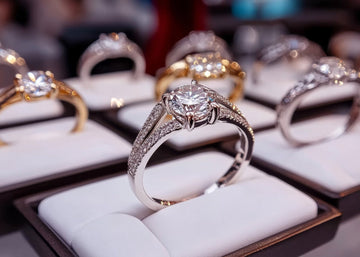Diamond Education

Diamond Education at Meierotto Jewelers
The 4Cs of Quality
At Meierotto Jewelers, we believe choosing a diamond should be a special and informed experience. Learn about the 4Cs – Color, Clarity, Cut, and Carat – and understand how each factor affects the beauty and value of your diamond.




The color evaluation of gem-quality diamonds is based on the absence of color. A chemically pure and structurally perfect diamond has no hue and consequently, a higher value.
The Gemological Institute of America's diamond grading scale is the industry's most widely accepted and respected grading system. The scale begins with the letter D, representing a colorless diamond, and continues, with increasing presence of color, to the letter Z. The diamond’s color is established by comparing a diamond under controlled lighting and viewing conditions against a set of master stones.
Many of these color distinctions are so subtle that they are invisible to the untrained eye. These distinctions, however, make a very big difference in diamond pricing.
Natural diamonds are the result of carbon exposed to tremendous heat and pressure deep within the earth. This process can result in a variety of internal characteristics called ‘inclusions’
Evaluating diamond clarity involves determining the quantity, size, relief, nature, and position of these characteristics, as well as how they affect the overall appearance of the stone.
Diamond carat weight is the measurement of how much a diamond weighs which directly correlates to the size of a stone. A metric “carat” is defined as 200 milligrams. Each carat can be divided into 100 ‘points.’ This allows a precise measurement to the hundredth decimal place. Diamond price generally increases with diamond carat weight if all other factors and grades of the diamond are the same. This is the case because larger diamonds are far more rare and more desirable.
Diamond carat weight is the measurement of how much a diamond weighs which directly correlates to the size of a stone. A metric “carat” is defined as 200 milligrams. Each carat can be divided into 100 ‘points.’ This allows a precise measurement to the hundredth decimal place. Diamond price generally increases with diamond carat weight if all other factors and grades of the diamond are the same. This is the case because larger diamonds are far more rare and more desirable.

Natural Diamonds vs. Lab-Grown Diamonds
-
Overview: Both natural and lab-grown diamonds are visually identical and share the same physical and chemical properties. The main difference lies in their origin.
Natural Diamonds: Natural diamonds are formed over billions of years deep within the Earth. Each stone is unique and prized for its rarity, although mining can have environmental and social impacts.
Lab-Grown Diamonds: Lab-grown diamonds are created using advanced technology that replicates the conditions of natural formation. They are considered a more sustainable and ethical choice and are generally more affordable.
Choosing the Right Diamond: Both are genuine diamonds. The best choice depends on your personal values and what you are looking for in a piece of jewelry.


